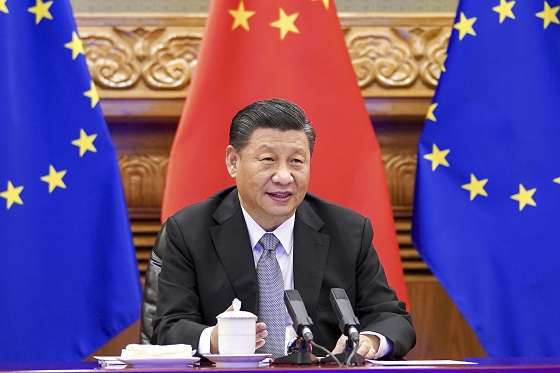Economy
European Voters Are Taking Sledgehammer To Continent’s Radical Open Borders And Climate Agenda

 From the Daily Caller News Foundation
From the Daily Caller News Foundation
By RICHARD HOLT
The results from both the recent European Parliamentary elections and France’s snap legislative elections have surprised our socialist friends across the ocean.
Despite the consistent rejection of climate activism in national elections, the ultra-left European Union Parliament has continued to loom darkly on its subjugated member states with failing “climate” and “open border” policies. The election results are more than just a passing trend: they are a clear repudiation of the left-wing policies on immigration and climate that have dominated the EU’s agenda in recent years.
Voters across Europe have expressed their dissatisfaction with these policies, which they perceive as economically burdensome and socially disruptive. In Germany, for example, center-right Christian Democrats (CDU) secured 30.2% of the vote, while the conservative Alternative for Germany (AfD) surged to 16%, a significant increase from their previous performance. This rise in support for the AfD is a direct response to the German government’s aggressive climate policies and its handling of immigration.
The German government’s climate agenda — particularly the Energiewende, has placed a heavy financial burden on households and businesses. Within the framework is a policy called “Marginal Pricing.” This means that the price of electricity at any given time is set by the most expensive power plant needed to meet demand at that moment. The overall transition to renewable energy has led to some of the highest electricity prices in Europe, with German households paying significantly more than the European average. These high costs have not only strained family budgets but have also impacted the competitiveness of German industries, leading to job losses and economic uncertainty.
Moreover, the decision to phase out coal and nuclear energy without adequate alternatives has left the country reliant on costly and inconsistent renewable sources. This dual energy system has created inefficiencies and further driven up costs. The frustration over these economic pressures has been a significant factor in the rise of conservative parties, who promise to alleviate these burdens by rolling back stringent climate regulations.
Immigration policies have also played a crucial role in the electorate’s shift to the right. Germany, and indeed much of Europe, has experienced a significant influx of asylum seekers over the past decade. The public’s growing concern over immigration, coupled with the perceived inability of left-wing parties to manage this influx effectively, has driven voters toward conservative alternatives. The AfD, for instance, has capitalized on these concerns, positioning itself as the defender of national borders and cultural identity.
This trend is not confined to Germany. In France, the legislative elections held this weekend show a significant shift to the right there as well. Marine Le Pen’s National Rally garnered over 33% of the vote, a dramatic win reflecting public dissatisfaction with Macron’s failed policies. Macron’s policies in regards to taxes, pensions and immigration coupled with long-term protests has eroded support for his centrist alliance, which only received about 21% of the vote. The left-wing New Popular Front, including La France Insoumise and the Socialist Party, trailed with around 28% of the vote. This rightward shift is part of a broader European trend where voters are increasingly turning to conservative parties in response to economic strain and immigration concerns.
The success of these parties underscores a growing demand for policies that prioritize national sovereignty and economic pragmatism over ideological commitments to climate activism and open borders. Voters are increasingly skeptical of policies that they perceive as detached from the realities of everyday life. The economic strain of high energy costs, combined with the social challenges of integrating large numbers of immigrants, has fueled a backlash against the left-wing establishment.
The rightward shift in the elections for the European Parliament is a powerful statement against the dubious feel-good policies from a failed left-wing activism on climate and immigration. It is a demand for a more market-centered approach that considers the economic and social realities faced by regular Europeans. The rise of conservative parties across the continent is not just a political realignment but a profound demand for sanity.
Richard Holt is an ambassador for Project 21, an initiative of The National Center for Public Policy Research to promote the views of African-Americans whose entrepreneurial spirit, dedication to family and commitment to individual responsibility have not traditionally been echoed by the nation’s civil rights establishment. He is also a political consultant at Sirius Campaigns with over two decades of experience working on campaigns for local, state and federal offices across the country.
The views and opinions expressed in this commentary are those of the author and do not reflect the official position of the Daily Caller News Foundation.
Featured image credit: Marine Le Pen (Screen Capture/CSPAN)
Business
Trump: China’s tariffs to “come down substantially” after negotiations with Xi

 MxM News
MxM News
Quick Hit:
President Trump said the 145% tariff rate on Chinese imports will drop significantly once a deal is struck with Chinese President Xi Jinping, expressing confidence that a new agreement is on the horizon.
Key Details:
- Trump said the current 145% tariff rate on China “won’t be anywhere near that high” after negotiations.
- He pointed to his relationship with Xi Jinping as a reason for optimism.
- The White House said it is preparing the groundwork for a deal, and Treasury officials expect a “de-escalation” of the trade war.
Diving Deeper:
President Donald Trump on Tuesday told reporters that the steep tariff rate currently imposed on Chinese imports will come down substantially after his administration finalizes a new trade deal with Chinese President Xi Jinping. While the current level stands at 145%, Trump made clear that number was temporary and would be adjusted following talks with Beijing.
“145 percent is very high. It won’t be that high, it’s not going to be that high … it won’t be anywhere near that high,” Trump said from the Oval Office, signaling a shift once a bilateral agreement is reached. “It will come down substantially, but it won’t be zero.”
The tariff, which Trump previously described as “reciprocal,” was maintained on China even after he delayed similar penalties on other trading partners. Those were cut to 10% and paused for 90 days to allow room for further negotiation.
“We’re going to be very nice. They’re going to be very nice, and we’ll see what happens. But ultimately, they have to make a deal because otherwise they’re not going to be able to deal in the United States,” Trump said, reinforcing his view that the U.S. holds the leverage.
Trump’s remarks come as markets remain wary of ongoing trade tensions, though the White House signaled progress, saying it is “setting the stage for a deal with China.” The president cited his personal rapport with Xi Jinping as a key factor in his confidence that an agreement can be reached.
“China was taking us for a ride, and it’s not going to happen,” Trump said. “They would make billions a year off us and build up their military with our money. That’s over. But we’ll still be good to China, and I think we’ll work together.”
Treasury Secretary Scott Bessent also said Tuesday that he expects a cooling of trade hostilities between the two nations, according to several reports from a private meeting with investors.
As the 90-day pause on other reciprocal tariffs nears its end, Trump emphasized that his team is prepared to finalize deals quickly. “We’ve been in talks with many, many world leaders,” he said, expressing confidence that talks will “go pretty quickly.”
White House Press Secretary Karoline Leavitt added that the administration has received 18 formal proposals from other countries engaged in trade negotiations, another sign that momentum is building behind Trump’s broader push to restructure global trade in favor of American workers and businesses.
(Li Xueren/Xinhua via AP)
2025 Federal Election
Next federal government should end corporate welfare for forced EV transition

From the Fraser Institute
By Tegan Hill and Jake Fuss
Corporate welfare simply shifts jobs and investment away from other firms and industries—which are more productive, as they don’t require government funding to be economically viable—to the governments’ preferred industries and firms, circumventing the preferences of consumers and investors. And since politicians spend other people’s money, they have little incentive to be careful investors.
General Motors recently announced the temporary closure of its electric vehicle (EV) manufacturing plant in Ontario, laying off 500 people because its new EV isn’t selling. The plant will shut down for six months despite hundreds of millions in government subsides financed by taxpayers. This is just one more example of corporate welfare—when governments subsidize favoured industries and companies—and it’s time for the provinces and the next federal government to eliminate it.
Between the federal government and Ontario government, GM received about $500 million to help fund its EV transition. But this is just one example of corporate welfare in the auto sector. Stellantis and Volkswagen will receive about $28 billion in government subsidies while Honda is promised $5 billion.
More broadly, from 2007 to 2019, the last pre-COVID year of data, the federal government spent an estimated $84.6 billion (adjusted for inflation) on corporate welfare while provincial and local governments spent another $302.9 billion. And crucially, these numbers exclude other forms of government support such as loan guarantees, direct investments and regulatory privileges, so the actual cost of corporate welfare during this period was much higher.
Of course, politicians claim that corporate welfare benefits workers. Yet according to a significant body of research, corporate welfare fails to generate widespread economic benefit. Think of it this way—if the businesses that received subsidies were viable to begin with, they wouldn’t need government support. So unprofitable companies are kept in business through governments’ support, which can prevent resources, including investment and workers, from moving to profitable companies, hurting overall economic growth.
Put differently, rather than fuelling economic growth, corporate welfare simply shifts jobs and investment away from other firms and industries—which are more productive, as they don’t require government funding to be economically viable—to the governments’ preferred industries and firms, circumventing the preferences of consumers and investors. And since politicians spend other people’s money, they have little incentive to be careful investors.
Governments also must impose higher tax rates on everyone else to pay for corporate welfare. In turn, higher tax rates discourage entrepreneurship and business investment—again, which fuels economic growth. And the higher the tax rates, the more economic activity they discourage.
GM’s EV plant shut down once again proves that when governments try to engineer the economy with corporate welfare, workers will ultimately lose. It’s time for the provinces and the next federal government—whoever it may be—to finally put an end to this costly and ineffective policy approach.
-

 2025 Federal Election2 days ago
2025 Federal Election2 days agoOttawa Confirms China interfering with 2025 federal election: Beijing Seeks to Block Joe Tay’s Election
-

 2025 Federal Election1 day ago
2025 Federal Election1 day agoBREAKING: THE FEDERAL BRIEF THAT SHOULD SINK CARNEY
-

 2025 Federal Election2 days ago
2025 Federal Election2 days agoHow Canada’s Mainstream Media Lost the Public Trust
-

 2025 Federal Election2 days ago
2025 Federal Election2 days agoReal Homes vs. Modular Shoeboxes: The Housing Battle Between Poilievre and Carney
-

 John Stossel1 day ago
John Stossel1 day agoClimate Change Myths Part 2: Wildfires, Drought, Rising Sea Level, and Coral Reefs
-

 2025 Federal Election1 day ago
2025 Federal Election1 day agoCHINESE ELECTION THREAT WARNING: Conservative Candidate Joe Tay Paused Public Campaign
-

 Media1 day ago
Media1 day agoCBC retracts false claims about residential schools after accusing Rebel News of ‘misinformation’
-

 Business1 day ago
Business1 day ago‘Great Reset’ champion Klaus Schwab resigns from WEF







